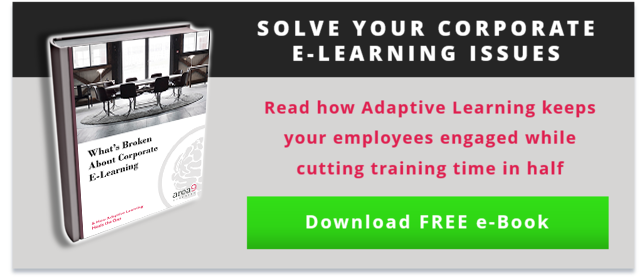One of the biggest benefits of e-learning is that it is convenient. But many feel there is no substitute for in-classroom learning. Research shows that the combination of the two - blended learning - combines the advantages of each for better outcomes; here are some of the things you need to know about how the benefits of blended learning can improve corporate learning program.
Why Adaptive Learning Improves a Blended Learning Program
Adaptive Learning is personalized corporate e-learning but delivered at scale so every learner gets the benefit of electronic one-on-one tutoring. By personalizing to every learner, Adaptive Learning ensures that learners only see content that they need to know and never waste time with the things they don’t. Thus, with Adaptive Learning, learners spend less time in corporate training sessions (up to 50% less time) and more time applying what they’ve learned to their roles.
Area9’s Adaptive Learning platform can be accessed on any device - desktop, tablet or phone - which maximizes convenience for the learner. Thus, anywhere that you use e-learning in your current corporate learning or blended learning platform, you can use Adaptive Learning.
Because Adaptive Learning frees up instructors to take advantage of valuable face-to-face learning time, it plays a key role in the success of your classroom training in a blended learning program.
How Does Adaptive Learning Benefit Blended Learning?
Adaptive Learning is an ideal component of a flipped classroom scenario. A flipped classroom is a learning strategy that flips the traditional learning environment on its head. The flipped classroom has students engage with learning content online, outside of the classroom. It relieves the instructor of having to lecture to a classroom; the learners already know the content. This creates an opportunity for the instructor to better engage with the class.
Because learners complete training ahead of time, the instructor knows that each learner is ready for the classroom part of the blended program. In-class time is better spent in group discussions, role-plays, and practical and experiential scenarios.
Even better, the personalized element of Adaptive Learning - online learning outside of the classroom - engages users because they realize they are learning the things most relevant to their needs.
Adaptive Learning Takes Blended Learning a Step Further
Adaptive Learning can replace the e-learning content of a blended learning program. But it can also go a step further. If you’re using a blended learning classroom, look at the in-classroom content and see if classroom time is being used efficiently. Most likely, you’ll find in-class learning content that is better suited for personalized Adaptive Learning, freeing your instructors up for better engagement, discussion, and socialization.
Learn What Else Adaptive Learning Can Do for Your Business
Integrating with a blended classroom is just one of the things that Adaptive Learning can do. Learn more about Adaptive Learning and how it can improve blended learning when you download this free e-book.










